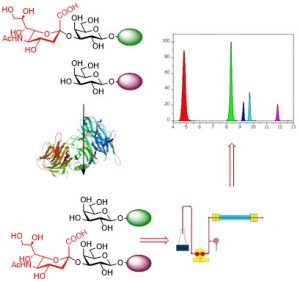Síntesis de hidratos de carbono como sustratos alternativos o inhibidores de la trans-sialidasa de Trypanosoma cruzi
Directora del grupo:
Dra. Rosalia Agusti. Investigadora Adjunta CONICET– Profesora Adjunta (DS), DQO, FCEN, UBA.
Integrantes:
Lic. Pablo Damián Morrone. Becario doctoral CONICET- Jefe de Trabajos Prácticos (DS), DQO, FCEN, UBA.
Resumen
En Trypanosoma cruzi, agente del Mal de Chagas, la enzima trans-sialidasa constituye un blanco excepcional para el diseño de agentes quimioterapéuticos ya que no existe una actividad similar en mamíferos. TcTS cataliza la transferencia de residuos de ácido siálico desde sialilglicoconjugados del hospedero hacia unidades terminales de β-galactopiranosas presentes en las mucinas del parásito. Al modificar el perfil de sialilación tanto en el parásito como en la célula huésped, la enzima participa activamente de los mecanismos de evasión del sistema inmune, invasión celular y apoptosis de células rojas sanguíneas.
TcTS tiene dos (sub)sitios en el centro catalítico: el sitio de unión del ácido siálico y el sitio de unión de la galactosa. Nuestras investigaciones están dirigidas hacia el desarrollo de inhibidores del sitio aceptor de β-galactósidos, por ser más específico ya que esta interacción no está presente en las sialidasas bacterianas. La estrategia utilizada consiste en la síntesis de sustratos naturales, su modificación para la identificación de las estructuras que determinan la interacción con la enzima y el diseño de inhibidores de la misma. Sintetizamos también neoglicoconjugados de los oligosacáridos por conjugación con polietilenglicol (PEGilación) o con péptidos y proteínas para ser utilizados como herramientas en inmunodiagnosis.
Las reacciones de trans-sialidación a escala analítica se evalúan por cromatografía de intercambio aniónico de alta resolución (HPAEC). Las sialilaciones a escala preparativa se purifican por intercambio aniónico o cromatografía de adsorción, su pureza se determina por HPAEC y la determinación estructural se realiza por métodos espectroscópicos (RMN y EM).
Abstract
In Trypanosoma cruzi, the agent of Chagas disease, the trans-sialidase represents an exceptional target for chemotherapeutic agents design since this activity is absent in mammals. TcTS transfers sialic acid from the host sialoglycoconjugates to the terminal β-galactopyranoses residues in the mucins of the parasite. By modifying the sialylation pattern both in the parasite and in the host cell, it actively participates in evasion of the immune system, cell invasion and red blood cell apoptosis.
TcTS has two subsites in the catalytic center: one for the sialic acid donor and the other for galactose binding. Our research is directed towards the design of inhibitors of the galactose binding site due to its specificity, since this site is absent in bacterial sialidases. The strategy consists in the synthesis of natural substrates, their modification for the identification of the structures that determine the interaction with the enzyme and the design of inhibitors. We also synthesize neoglycoconjugates by conjugation with polyethylene glycol (PEGylation) or selected proteins or peptides in order to be used as tools for immune diagnosis.
Analytical trans-sialylations are monitored by high performance anion exchange chromatography (HPAEC). The products of preparative trans-sialylations are isolated by adsorption or ion exchange chromatography, the purification process analyzed by HPAEC and the structural determination performed by spectroscopic techniques (NMR and MS).
Publicaciones seleccionadas / Selected publications
Structure-based virtual screening of new benzoic acid derivatives as Trypanosoma cruzi trans-sialidase inhibitors. Vázquez-Jiménez, L.K., Paz-González, A.D., Juárez-Saldivar, Uhrig, M.L., Agusti, R., Reyes-Arellano, A., Nogueda-Torres, B., Rivera, G. Medicinal Chemistry, 17(7), 724–731 (2021).
Trypanosoma cruzi trans-sialidase. A tool for the synthesis of sialylated oligosaccharides. Agusti, R., Gallo-Rodriguez, C., Lederkremer, R. M. Carbohydr. Res., 479, 48–58 (2019).
Trypanosoma cruzi trans-sialidase alternative substrates: Study of the effect of substitution in C-6 in benzyl β-lactoside. Morrone-Pozzuto, P., Uhrig, M.L., Agusti, R. Carbohydr. Res., 478, 33–45 (2019).
Glycan-targeted PEGylation for selective modification of proteins. Giorgi, M.E., Agusti, R.; Lederkremer, R.M. In: Polymer-Protein Conjugates: From Pegylation and Beyond, pp. 235–250 (2019).
Synthesis of a model trisaccharide for studying the interplay between the anti α-Gal antibody and the trans-sialidase reactions in Trypanosoma cruzi. Giorgi, M.E., Lopez, R., Agusti, R., Marino, C., Lederkremer, R.M. Carbohydr. Res., 450, 30-37 (2017).
Multivalent sialylation of β-thio-glycoclusters by Trypanosoma cruzi trans sialidase and analysis by High Performance Anion Exchange Chromatography. Agusti, R.; Cano, M.E.; Cagnoni, A.J.; Kovensky, J.; Lederkremer, R.M., Uhrig, M.L. Glycoconj. J., 33, 809-818 (2016).
Synthesis of the O-linked hexasaccharide containing β-D-Galp-(1→2)-D-Galf in Trypanosoma cruzi mucins. Differences on sialylation by trans-sialidase of the two constituent hexasaccharides. Agusti, R.; Giorgi, M.E.; Mendoza, V.M.; Kashiwagi, G.; Lederkremer, R.M., Gallo-Rodríguez, C. Bioorg. Med. Chem., 23, 1213-1222 (2015).
